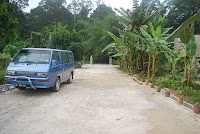 Many of us are familar with the tapioca as a good carbohydrate food source and some are familar that is used to produce a popular food flavor enhancer commonly known as monosodium glutamate or MSG. A widely-known brand in Malaysia is Aji-no-moto. There are many grandmother stories that eating a lot of MSG causes you to go bald but I have yet to find scientific proof of this. However, our "grandmothers" are wise and as in many traditional Malay grandmother stories, there must have been some reason as they tend to use euphemisms.
Many of us are familar with the tapioca as a good carbohydrate food source and some are familar that is used to produce a popular food flavor enhancer commonly known as monosodium glutamate or MSG. A widely-known brand in Malaysia is Aji-no-moto. There are many grandmother stories that eating a lot of MSG causes you to go bald but I have yet to find scientific proof of this. However, our "grandmothers" are wise and as in many traditional Malay grandmother stories, there must have been some reason as they tend to use euphemisms.  There are many varieties of tapiocas but at the farm three types are planted - ubi kayu merah, ubi kayu pulut and multi-colored leaf tapioca which I have named ubi kayu bunga. We do not plant the ubi kayu kuning as these are not as tender and has a more fibrous texture thus is used mainly for making tapioca chips or kerepek ubi kayu and fermented tapioca or tapai.
There are many varieties of tapiocas but at the farm three types are planted - ubi kayu merah, ubi kayu pulut and multi-colored leaf tapioca which I have named ubi kayu bunga. We do not plant the ubi kayu kuning as these are not as tender and has a more fibrous texture thus is used mainly for making tapioca chips or kerepek ubi kayu and fermented tapioca or tapai.  |
| Ubi kayu pulut leaf shoot |
 The tapioca plants can be used as windbreakers or as an ornamental with the added benefit of being an edible addition to your landscape. I paticularly love the multicolored leaves variety and plant them at the banks of my fish pond, This variety though is a slow grower and it produces a tender tapioca in about 10 months. There is also another variety that we plant at the farm which has a more needle-like leaf shape. This variety doesn't produce edible tubers and is planted for the leaves, which is more tender than the normal variety.
The tapioca plants can be used as windbreakers or as an ornamental with the added benefit of being an edible addition to your landscape. I paticularly love the multicolored leaves variety and plant them at the banks of my fish pond, This variety though is a slow grower and it produces a tender tapioca in about 10 months. There is also another variety that we plant at the farm which has a more needle-like leaf shape. This variety doesn't produce edible tubers and is planted for the leaves, which is more tender than the normal variety.  Tapioca is gluten free, rich in starch and contains a significant amount of calcium, phosphorus and vitamin C and protein free however the leaves are a good source of protein and rich in amino acid lysine.
Tapioca is gluten free, rich in starch and contains a significant amount of calcium, phosphorus and vitamin C and protein free however the leaves are a good source of protein and rich in amino acid lysine.The ubi kayu pulut tastes creamy and is the most tender of the species, I have even eaten this raw. It takes 10-15 minutes to cook and has a "fluffy" texture. According to "grandmother" stories, this was the favourite kind to replace rice during the Japanese occupation of Malaya. The ubi kayu merah is also tender when boiled and takes about 15-20 minutes to cooked when boiled. I prefer using the ubi kayu merah for desserts because it is "sweeter" and less creamy as our Malaysian desserts for the tapioca tend to include the use of coconut milk so the dessert may turn out to be too rich tasting.
For whatever dish you want to prepare, the tapioca is best cooked within 1-2 days after harvest. If you want to cook it a few days after buying, do not wash it or remove the outer layer of the skin and this will affect the taste and texture of the tuber. To test freshness, you can try to break the tapioca tuber and if it tends to "bend" than it is not so fresh.
Updated: 12 December 2014
.

















